In the ancient world of Greece, a land rich with legends and mythic heroes, one name stood out among them all—Heracles, the son of Zeus and a mortal woman, Alcmene. He was a figure of immense strength, courage, and resilience, destined to complete a series of impossible tasks to atone for a crime he had committed in a fit of madness inflicted upon him by the goddess Hera. These tasks, known as the Twelve Labors, would challenge Heracles beyond mortal limits and cement his place as one of the greatest heroes in Greek mythology. This is the story of how he achieved those incredible feats and earned his place among the gods. Heracles was the strongest of men, his prowess on the battlefield unmatched, his deeds the stuff of legends. Yet, even the mightiest of heroes have their weaknesses, and Heracles’ greatest weakness was his vulnerability to the machinations of the gods. Driven by an insatiable hatred for him, Hera, the wife of Zeus, sought to destroy Heracles, reminding him time and time again that his mortal mother was a stain upon his divine lineage. One day, Hera struck Heracles with madness. In this delusional state, Heracles turned on his own family, believing them to be enemies. When he awoke from this madness, the horror of what he had done crashed over him like a tidal wave. Desperate to atone for his sins, Heracles sought guidance from the Oracle of Delphi. The Oracle, under the influence of Hera, declared that Heracles must serve King Eurystheus of Mycenae and complete twelve labors. Only then would he be free of his guilt and the madness that plagued him. King Eurystheus, eager to see Heracles fail, assigned him a seemingly impossible task: to slay the Nemean Lion, a fearsome beast whose hide was impervious to weapons. The lion terrorized the region of Nemea, and many brave warriors had met their end trying to defeat it. Undeterred, Heracles set out on his journey. Upon arriving in Nemea, Heracles tracked the lion to its lair. He realized that no weapon could pierce the creature’s skin, so he discarded his sword and bow. Instead, he wrestled the lion with his bare hands, displaying his immense strength. After a fierce struggle, Heracles managed to choke the lion to death. He then skinned the beast with its own claws and wore its impenetrable hide as armor, returning to Eurystheus with proof of his success. For the second labor, Eurystheus sent Heracles to the swamps of Lerna, where a monstrous serpent known as the Hydra lurked. This creature had nine heads, one of which was immortal, and every time one head was cut off, two more would grow in its place. To make the task even more difficult, Hera sent a giant crab to aid the Hydra. Heracles approached the beast cautiously. As he severed each head, two more emerged, threatening to overwhelm him. Realizing he needed a different strategy, he called upon his nephew, Iolaus, for assistance. Each time Heracles cut off a head, Iolaus used a flaming torch to cauterize the wound, preventing new heads from sprouting. In this manner, they defeated the Hydra, and Heracles buried its immortal head under a massive rock. Before leaving, he dipped his arrows in the Hydra’s poisonous blood, a decision that would serve him in future battles. Eurystheus, frustrated by Heracles’ success, assigned a more challenging labor: to capture the Ceryneian Hind, a sacred deer of Artemis, the goddess of the hunt. The hind was known for its golden antlers, bronze hooves, and incredible speed, making it impossible to catch. Heracles chased the deer for an entire year, never giving up despite its swiftness. Finally, he managed to capture the hind without harming it, carrying it back to Mycenae. However, Artemis appeared before him, angered by the capture of her sacred creature. Heracles explained his plight, and the goddess, moved by his sincerity, allowed him to show the hind to Eurystheus before setting it free. This labor was thus completed, but it proved that Heracles’ challenges were not always about brute strength; patience and respect were equally vital. The next task was to capture the Erymanthian Boar alive. This monstrous creature roamed Mount Erymanthos, terrorizing the land with its ferocity. Heracles ascended the mountain, facing harsh weather and treacherous terrain. He used his cunning to chase the boar into a deep snowbank, where it became trapped and could no longer move. Heracles bound the boar and carried it to Mycenae on his shoulders. When Eurystheus saw Heracles approaching with the snarling beast, he was so frightened that he hid in a large bronze jar, refusing to come out until Heracles had left. This labor highlighted Heracles’ ability to overcome not just physical challenges but also psychological ones, as he instilled fear in those who opposed him. For his fifth labor, Heracles faced a task that seemed more degrading than dangerous. He was ordered to clean the Augean Stables, which housed thousands of cattle that had not been cleaned in years. The filth was overwhelming, and Eurystheus was certain that Heracles would be unable to complete the task. However, Heracles’ ingenuity proved otherwise. He diverted two nearby rivers, Alpheus and Peneus, so that they flowed through the stables, washing away years of accumulated filth in a single day. Despite completing the labor successfully, Eurystheus refused to acknowledge it, claiming Heracles had cheated by using the rivers. Nonetheless, Heracles remained undeterred and continued his quest. Next, Heracles was tasked with driving away the Stymphalian Birds, man-eating creatures with metallic feathers that could shoot like arrows. These birds had taken up residence in a marsh near Lake Stymphalia, terrorizing the nearby villages. Their numbers were vast, and their presence was deadly. To complete this task, Heracles received aid from the goddess Athena, who provided him with a pair of bronze clappers. Using these, Heracles created a loud noise that startled the birds, driving them into the air. As they took flight, he shot them down with his bow and poisoned arrows, clearing the region of this deadly threat. For his seventh labor, Heracles was sent to Crete to capture a mighty bull that was terrorizing the island. This bull was sacred to Poseidon, but King Minos of Crete had failed to sacrifice it, as promised, which led to the bull’s rampage. Heracles wrestled the beast into submission and brought it back to Eurystheus, demonstrating his strength once more. Eurystheus, however, released the bull, and it wandered into the countryside, eventually making its way to Marathon, where it would cause more chaos in the future. This labor showed that even completed tasks could have lingering consequences. Heracles’ next labor was to capture the Mares of Diomedes, a set of flesh-eating horses owned by the Thracian king. Heracles and his companions overpowered the grooms and drove the mares to the sea. When Diomedes arrived with his men, Heracles killed him and fed him to his own horses, which tamed them. He then brought the mares back to Eurystheus, who dedicated them to Hera. For the ninth labor, Eurystheus sent Heracles to retrieve the girdle of Hippolyta, the queen of the Amazons. Initially, Hippolyta was willing to give him the belt, but Hera, disguised as an Amazon, spread the rumor that Heracles was going to kidnap their queen. The Amazons attacked Heracles, and in the ensuing battle, he killed Hippolyta and took her belt, completing the labor. The tenth labor required Heracles to travel to the far-off island of Erytheia and steal the cattle of the giant Geryon, a three-bodied monster. After a long journey, Heracles defeated Geryon, his herdsman, and a two-headed guard dog before driving the cattle back to Eurystheus, enduring many hardships along the way. The penultimate labor was to obtain the golden apples of the Hesperides, guarded by a hundred-headed dragon named Ladon. Heracles sought advice from the sea god Nereus, who revealed their location. Upon reaching the garden, Heracles convinced Atlas, who held up the sky, to retrieve the apples for him while he temporarily took on Atlas’ burden. When Atlas returned, he attempted to leave Heracles holding the sky, but Heracles tricked him into taking it back, thus obtaining the apples. Finally, Eurystheus ordered Heracles to descend into the underworld and capture Cerberus, the three-headed guard dog of Hades. With the permission of Hades, Heracles wrestled Cerberus into submission and brought him to the surface, completing his final labor. Eurystheus, terrified, ordered Heracles to return Cerberus to the underworld immediately. Having completed all twelve labors, Heracles had proven himself worthy not only of his divine heritage but also of forgiveness for his past actions. His strength, courage, and ingenuity were unmatched, and his name would be remembered for eternity as the greatest hero in Greek mythology.The Madness of Heracles
The First Labor: The Nemean Lion
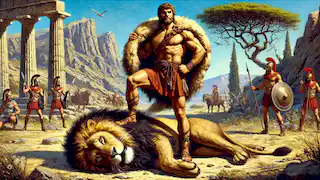
The Second Labor: The Lernaean Hydra
The Third Labor: The Ceryneian Hind
The Fourth Labor: The Erymanthian Boar
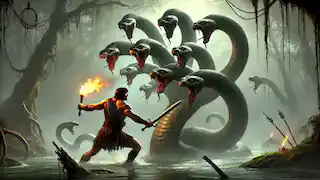
The Fifth Labor: The Augean Stables
The Sixth Labor: The Stymphalian Birds
The Seventh Labor: The Cretan Bull
The Eighth Labor: The Mares of Diomedes
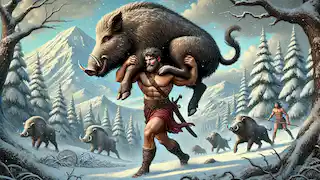
The Ninth Labor: The Belt of Hippolyta
The Tenth Labor: The Cattle of Geryon
The Eleventh Labor: The Apples of the Hesperides
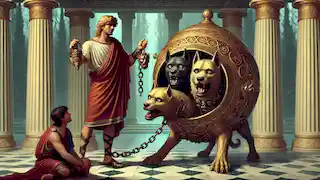
The Twelfth Labor: Cerberus
Conclusion
The Legend of the Labors of Heracles
Reading Time: 8 min
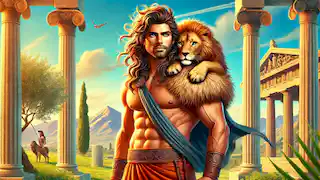
About Story: The Legend of the Labors of Heracles is a Myth Stories from greece set in the Ancient Stories. This Dramatic Stories tale explores themes of Courage Stories and is suitable for All Ages Stories. It offers Cultural Stories insights. The epic journey of Heracles as he completes the Twelve Labors, facing monsters, gods, and insurmountable challenges.


















